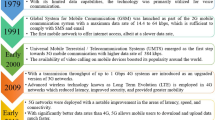Abstract
The efficient and fair coexistence of Licensed-Assisted-Access (LAA) and WLAN has become an urgent problem to be solved. According to the heat problems above, this thesis has conducted an in-depth research on access mechanism of LAA and WLAN systems in unlicensed frequency bands. The study firstly introduced an access mechanism based on reinforcement learning after making the summery of the existing coexistence mechanisms. This mechanism takes Listen Before Talk mechanism as a technical basis to have adaptive adjustment of the channel access probability, thus to increase the system capacity. Meanwhile, the system’s throughput is processed using a proportional fair utility function, and utility value is considered as the return value of the system to ensure fairness between the LAA and the WLAN. Simulation results indicate that the algorithm proposed in this study can effectively maximize the system throughput. In the case of different LAA and WLAN packet lengths, algorithm proposed can still guarantee fairness among users in coexistence system.











Similar content being viewed by others
References
Zhang, H., et al. (2017). Fronthauling for 5G LTE-U ultra dense cloud small cell networks. IEEE Wireless Communications,23(6), 48–53.
GPP. 3GPP TR 36. 899-2014. Study on Licensed-Assisted Access to Unlicensed Spectrum. France. 3GPP. 2015.
Wu, D., et al. (2016). Dynamic coding control in social intermittent connectivity wireless networks. IEEE Transactions on Vehicular Technology,65(9), 7634–7646.
Babaei, A., Andreoli-Fang, J., & Hamzeh, B. (2014). [IEEE 2014 IEEE 25th Annual International Symposium on Personal, Indoor, and Mobile Radio Communications (PIMRC)—Washington DC, USA (2014.9.2-2014.9.5)] 2014 IEEE 25th Annual International Symposium on Personal, Indoor, and Mobile Radio Communication (PIMRC)—On the Impact of LTE-U on Wi-Fi performance (pp. 1621–1625).
Wu, D., et al. (2018). Biologically inspired resource allocation for network slices in 5G-enabled Internet of Things. IEEE Internet of Things Journal. https://doi.org/10.1109/JIOT.2018.2888543.
Wu, D., Si, S., Wu, S., & Wang, R. (2018). Dynamic trust relationships aware data privacy protection in mobile crowd-sensing. IEEE Internet of Things Journal, 5(4), 2958–2970.
Wu, D., et al. (2018). Security-oriented opportunistic data forwarding in Mobile Social Networks. Future Generation Computer Systems 87, 803–815.
Rupasinghe, N., & Güvenç, İ. (2015). Reinforcement learning for licensed-assisted access of LTE in the unlicensed spectrum. In Wireless Communications and Networking Conference (pp. 1279–1284). Washington, DC: IEEE.
Almeida, E., et al. (2013). Enabling LTE/Wi-Fi coexistence by LTE blank subframe allocation. In Communications (ICC), 2013 IEEE International Conference on IEEE.
Tao, T., Han, F., & Liu, Y. (2015). [IEEE 2015 IEEE 26th Annual International Symposium on Personal, Indoor, and Mobile Radio Communications (PIMRC)—Hong Kong, China (2015.8.30-2015.9.2)] 2015 IEEE 26th Annual International Symposium on Personal, Indoor, and Mobile Radio Communications (PIMRC)—Enhanced LBT Algorithm for LTE-LAA in Unlicensed Band (pp. 1907–1911).
Kwan, R., et al. (2015). Fair co-existence of Licensed Assisted Access LTE (LAA-LTE) and Wi-Fi in unlicensed spectrum. In 2015 7th Computer Science and Electronic Engineering (CEEC). Washington, DC: IEEE.
Zhang, H., Huang, S., Jiang, C., et al. (2017). Energy efficient user association and power allocation in millimeter wave based ultra dense networks with energy harvesting base stations. IEEE Journal on Selected Areas in Communications,35(9), 1936–1947.
Deek, L., et al. (2014). Intelligent channel bonding in 802.11n WLANs. IEEE Transactions on Mobile Computing,13(6), 1242–1255.
Calì, F., Conti, M., & Gregori, E. (2000). Dynamic tuning of the IEEE 802.11 protocol to achieve a theoretical throughput limit. IEEE/ACM Transactions on Networking,8(6), 785–799.
Acknowledgements
This work was supported by the general project of science and technology program of Beijing Education Committee (No. KM201810858004).
Author information
Authors and Affiliations
Corresponding author
Additional information
Publisher's Note
Springer Nature remains neutral with regard to jurisdictional claims in published maps and institutional affiliations.
Rights and permissions
About this article
Cite this article
Chen, Y., Zhao, J., Zhu, Q. et al. Research on unlicensed spectrum access mechanism based on reinforcement learning in LAA/WLAN coexisting network. Wireless Netw 26, 1643–1651 (2020). https://doi.org/10.1007/s11276-019-02098-0
Published:
Issue Date:
DOI: https://doi.org/10.1007/s11276-019-02098-0




